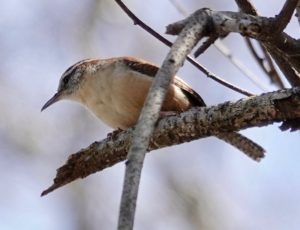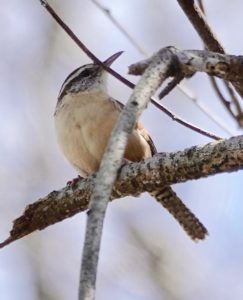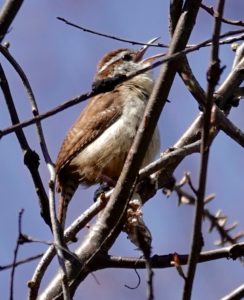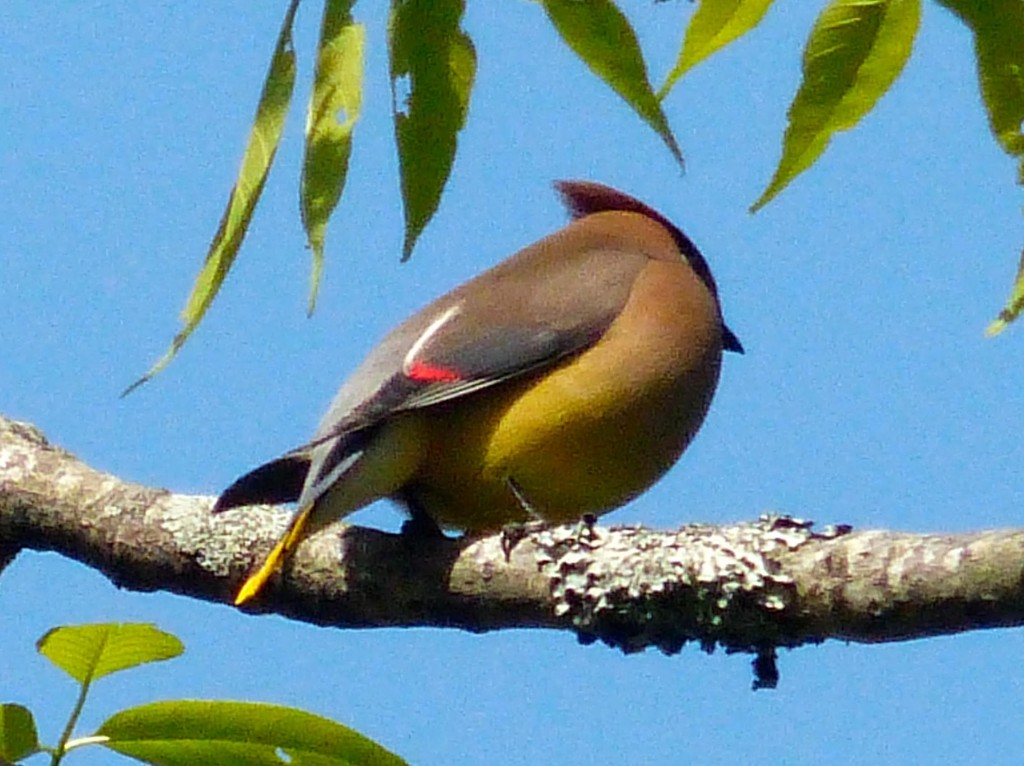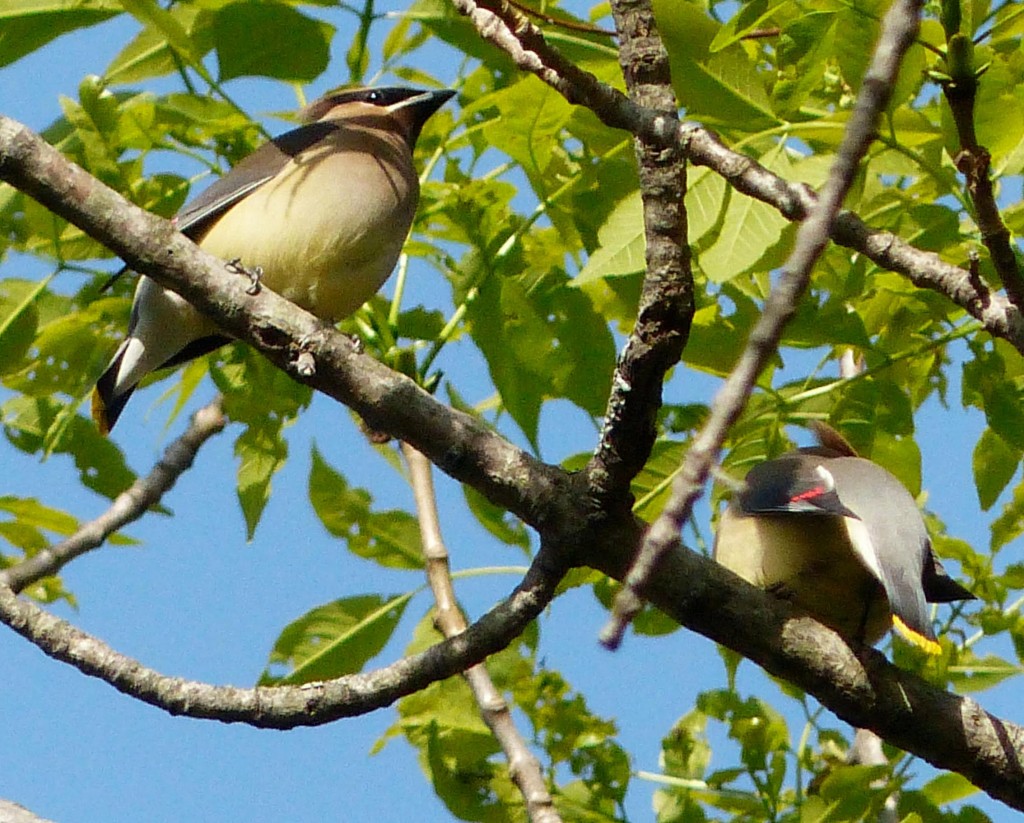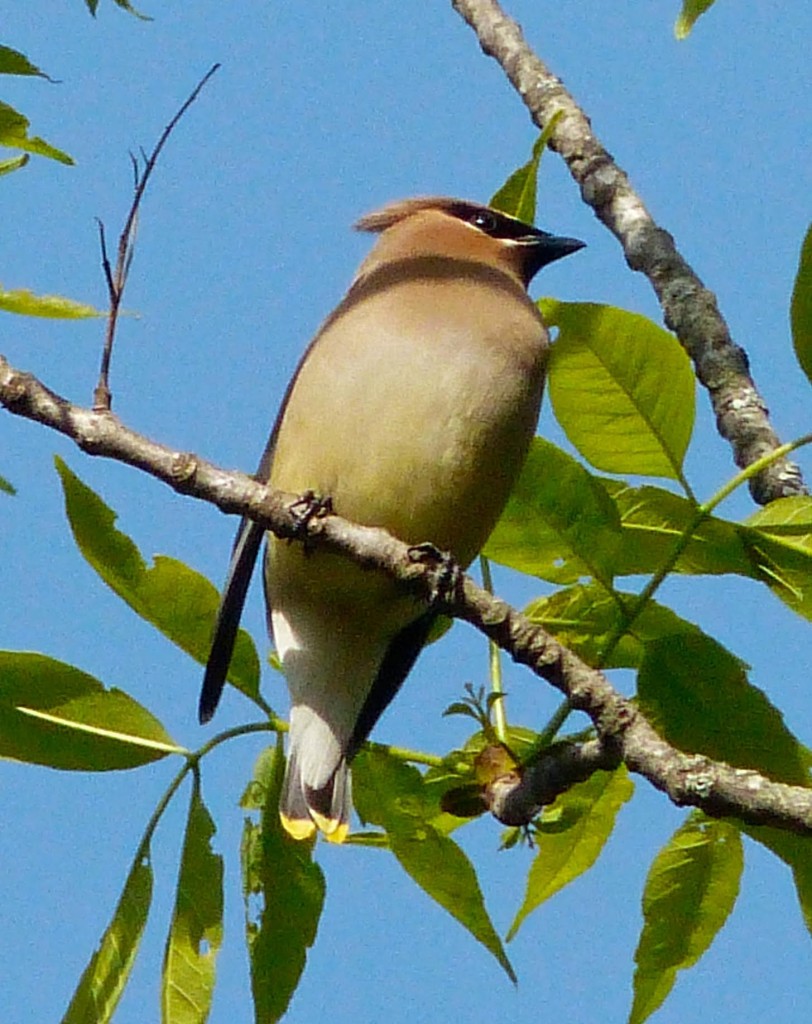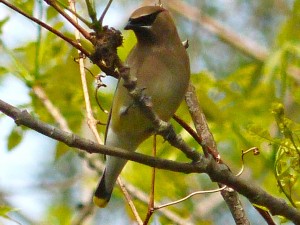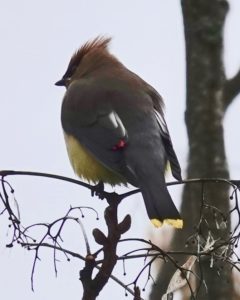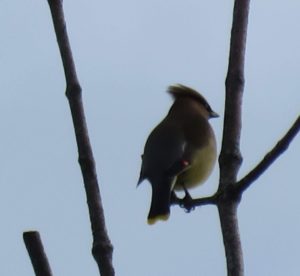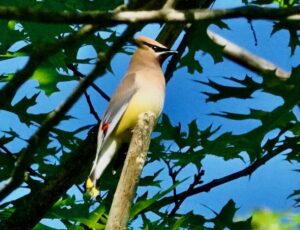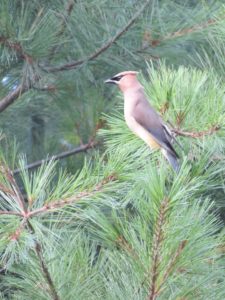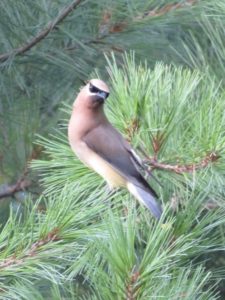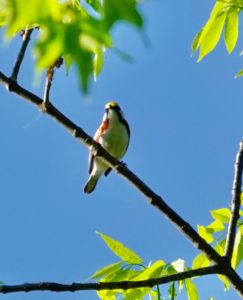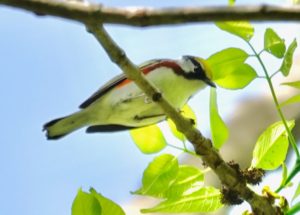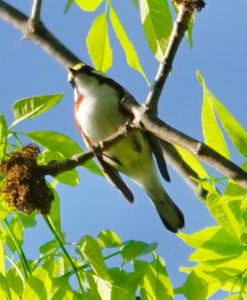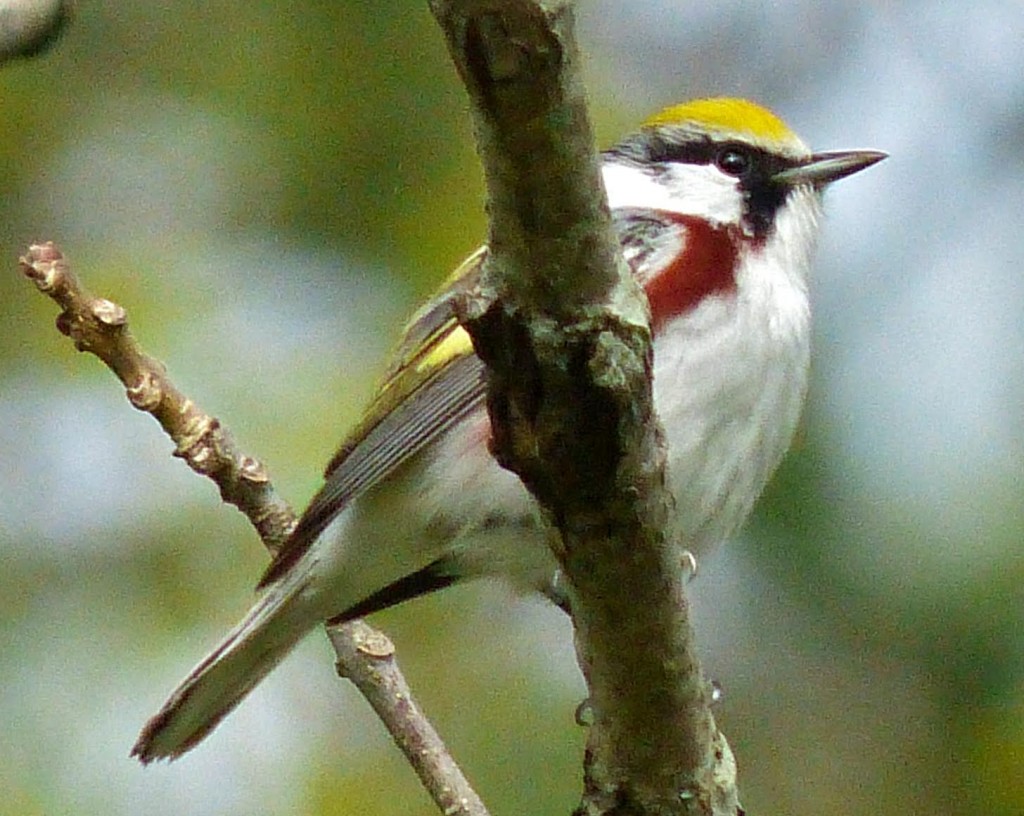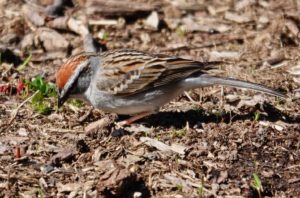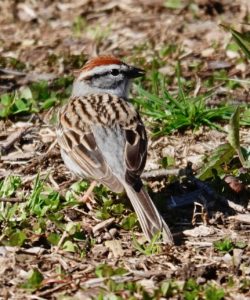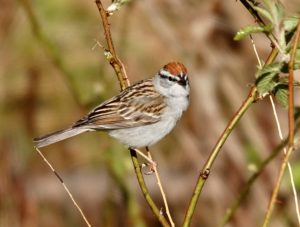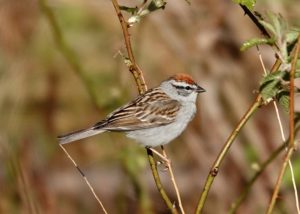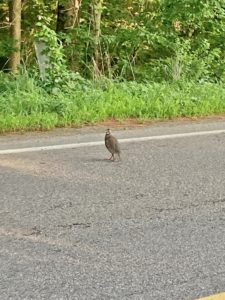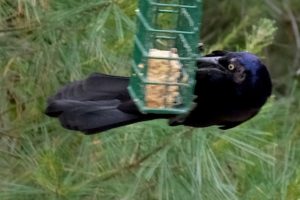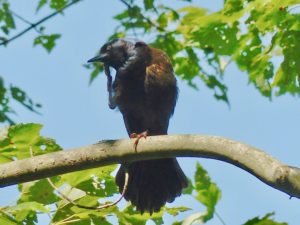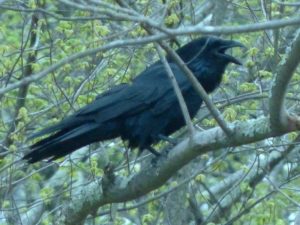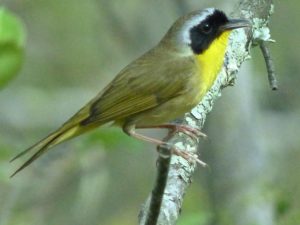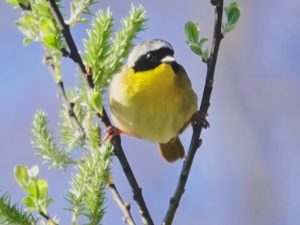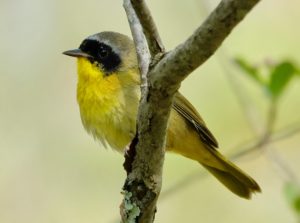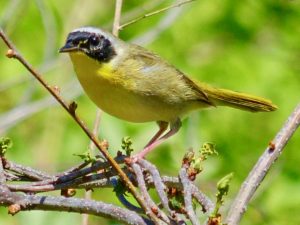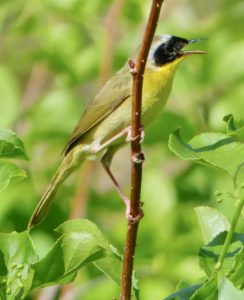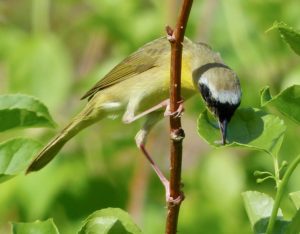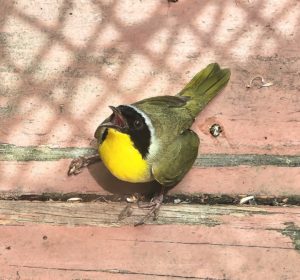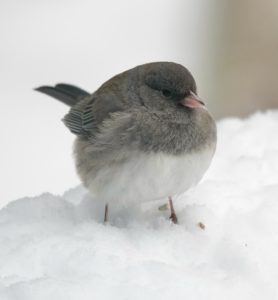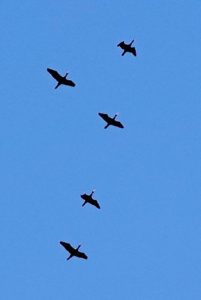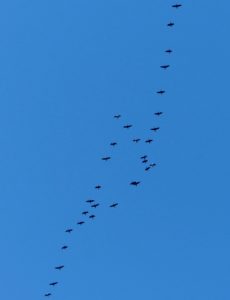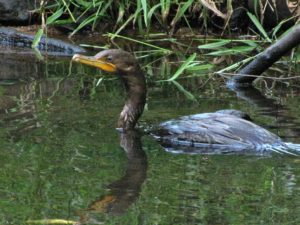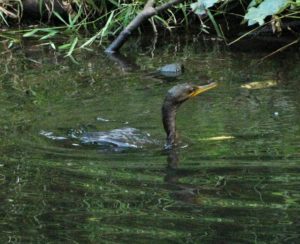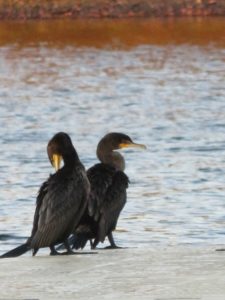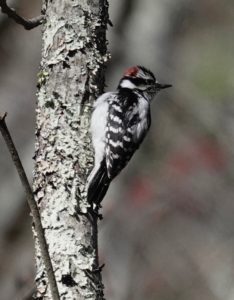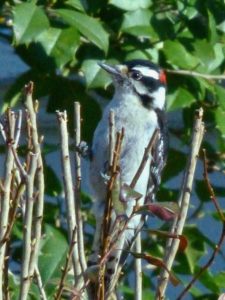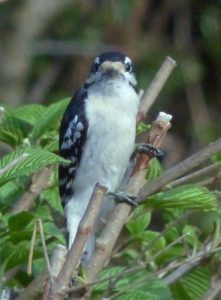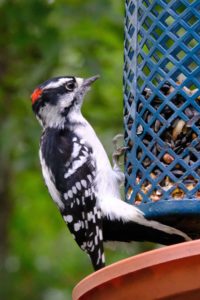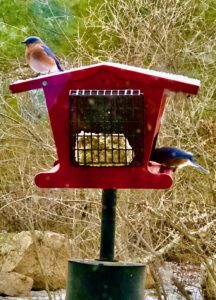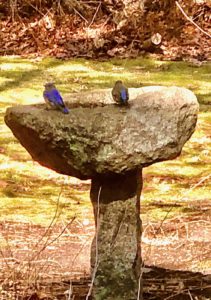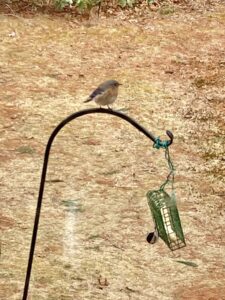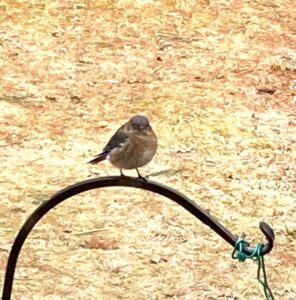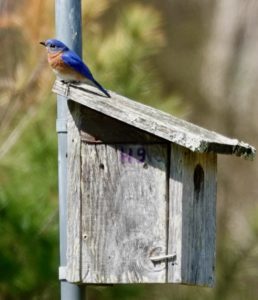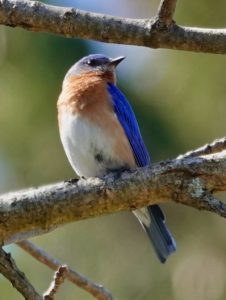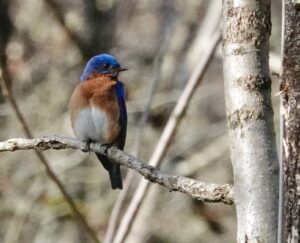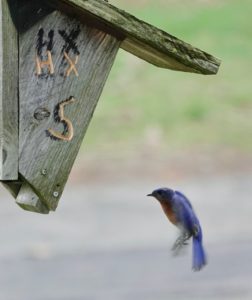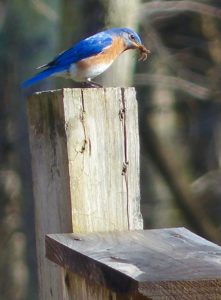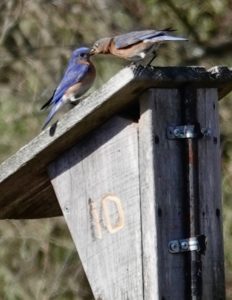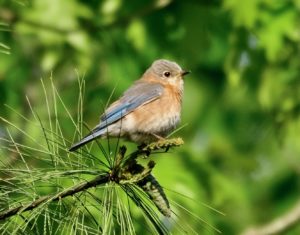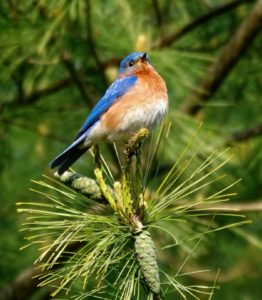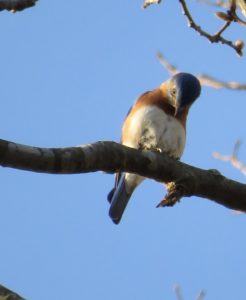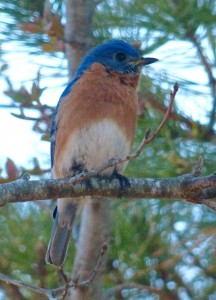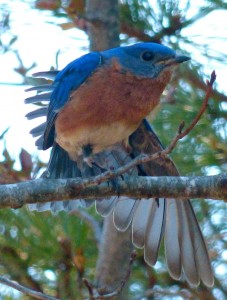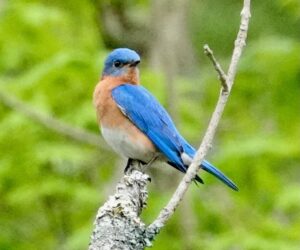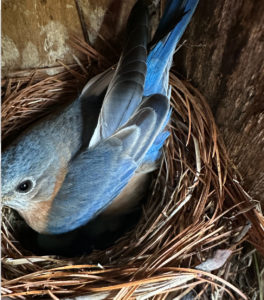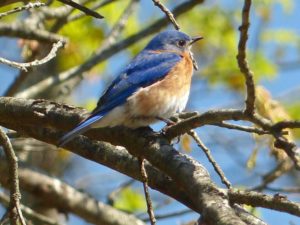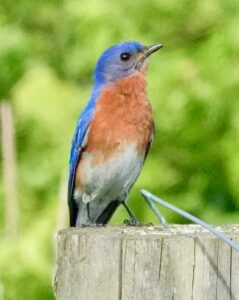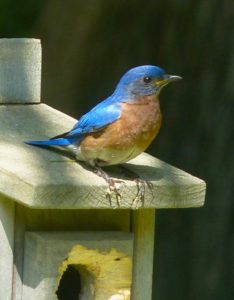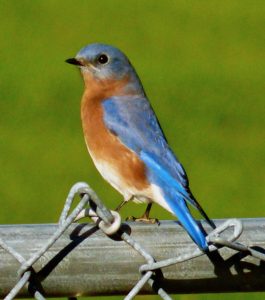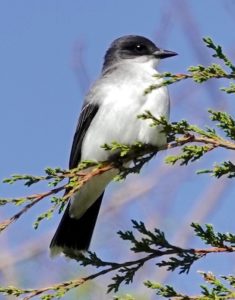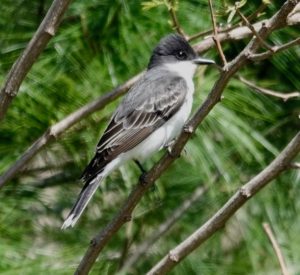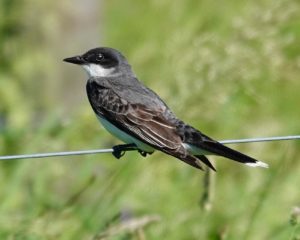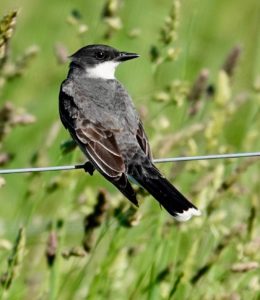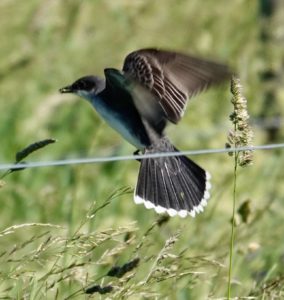Sightings – Birds
Observer: Paul Lauenstein
Observation Date: 4/25/20
Observation Time: 10:00 a.m.
Observation Location: Conservation land at Lakeview St. & Morse St.
Common Name: Carolina Wren
Scientific Name: Thryothorus ludovicianus
Comments: The Carolina Wren is sensitive to cold weather, with the northern populations decreasing markedly after severe winters. Global warming might be responsible for the northward range expansion seen in the late-1900s and early 2000’s.
A pair bond may form between a male and a female at any time of the year, and the pair will stay together for life. Members of a pair stay together on their territory year round, and forage and move around the territory together.
More Information: All About Birds
Observer: Paul Lauenstein
Observation Date: 5/15/15
Observation Time: 7:35 a.m.
Observation Location: Moose Hill Audubon Wildlife Sanctuary
Common Name: Cedar Waxwing
Scientific Name: Bombycilla cedrorum
Comments: These striking birds are typically seen in groups. Their tails look as if they were dipped in yellow paint. See:http://www.allaboutbirds.org/
Observer: Paul Lauenstein
Observation Date: 5/15/20
Observation Time: 6:45 a.m.
Observation Location: near Gavins Pond soccer parking area
Common Name: Cedar Waxwing
Scientific Name: Bombycilla cedrorum
Comments: These striking birds are typically seen in groups. Their tails look as if they were dipped in yellow paint.
More Information: http://www.allaboutbirds.org/
Observer: Deb Radovsky
Observation Date: 5/18/2016
Observation Time: N/A
Observation Location: Moose Hill area
Common Name: Cedar Waxwing
Scientific Name: Bombycilla cedrorum
Comments: Cedar Waxwings typically travel in groups.
More Information: All About Birds
Observer: Paul Lauenstein
Observation Date: 5/18/25
Observation Time: 8:40 a.m.
Observation Location: Moose Hill Audubon Wildlife Sanctuary
Common Name: Cedar Waxwing
Scientific Name: Bombycilla cedrorum
Comments: These striking birds are typically seen in groups. Their tails look as if they were dipped in yellow paint.
More Information: http://www.allaboutbirds.org/
Observer: Deb Radovsky
Observation Date: 8/2/20
Observation Time: 6:40 a.m.
Observation Location: along Lake Massapoag
Common Name: Cedar Waxwing
Scientific Name: Bombycilla cedrorum
Comments: Cedar Waxwings typically travel in groups.
More Information: All About Birds
Observer: Paul Lauenstein
Observation Date: 5/12/23
Observation Time: 7:20 a.m.
Observation Location: Moose Hill Audubon Wildlife Sanctuary
Common Name: Chestnut-sided Warbler
Scientific Name: Setophaga pensylvanica
Comments: Dazzling woodland warblers migrate through Sharon every spring on their way from South and Central America to Canada. Catching sight of one leaves an indelible impression.
More Information: All About Birds
Observer: Paul Lauenstein
Observation Date: 5/16/15
Observation Time: 8:20 a.m.
Observation Location: Moose Hill Audubon Wildlife Sanctuary
Common Name: Chestnut-sided Warbler
Scientific Name: Setophaga pensylvanica
Comments: Dazzling woodland warblers migrate through Sharon every spring on their way from South and Central America to Canada. Catching sight of one leaves an indelible impression.
More Information: All About Birds
Observer: Paul Lauenstein
Observation Date: 4/23/24
Observation Time: 9:30 a.m.
Observation Location: Moose Hill Audubon Wildlife Sanctuary
Common Name: Chipping Sparrow
Scientific Name: Spizella passerina
Comments: Chipping sparrows are common in Sharon. They have a distinctive reddish cap above a white eyeline. Their song is described as a reedy trill that sounds a lot like the songs of the pine warbler and the junco.
More Information: All About Birds
Observer: Paul Lauenstein
Observation Date: 4/28/23
Observation Time: 7:40 a.m.
Observation Location: Moose Hill Audubon Wildlife Sanctuary
Common Name: Chipping Sparrow
Scientific Name: Spizella passerina
Comments: Chipping sparrows are very common in Sharon. They have a distinctive reddish cap above a white eyeline. Their song is described as a reedy trill that sounds a lot like the songs of the pine warbler and the junco.
More Information: All About Birds
Observer: Paul Lauenstein
Observation Date: 5/20/13
Observation Time: 4:20 p.m.
Observation Location: Moose Hill Audubon Wildlife Sanctuary
Common Name: Chipping Sparrow
Scientific Name: Spizella passerina
Comments: Chipping sparrows are very common in Sharon. They have a distinctive reddish cap above a white eyeline. Their song is described as a reedy trill that sounds a lot like the songs of the pine warbler and the junco.
More Information: All About Birds
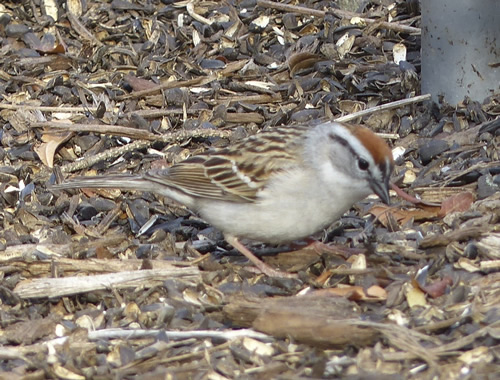
Observer: Deb Radovsky
Observation Date: 4/24/18
Observation Time: 5:00 p.m.
Observation Location: Moose Hill Audubon Wildlife Sanctuary, near bird feeders
Common Names: Chipping Sparrow and Dark-eyed Junco
Scientific Names: Spizella passerina and Junco hyemalis
Comments: If you want to get an idea of what birds are around, spend some time watching the feeders at the Moose Hill Audubon Wildlife Sanctuary. You’ll see everything from hummingbirds to wild turkeys.
More Information: All About Chipping Sparrows and All About Dark-eyed Juncos
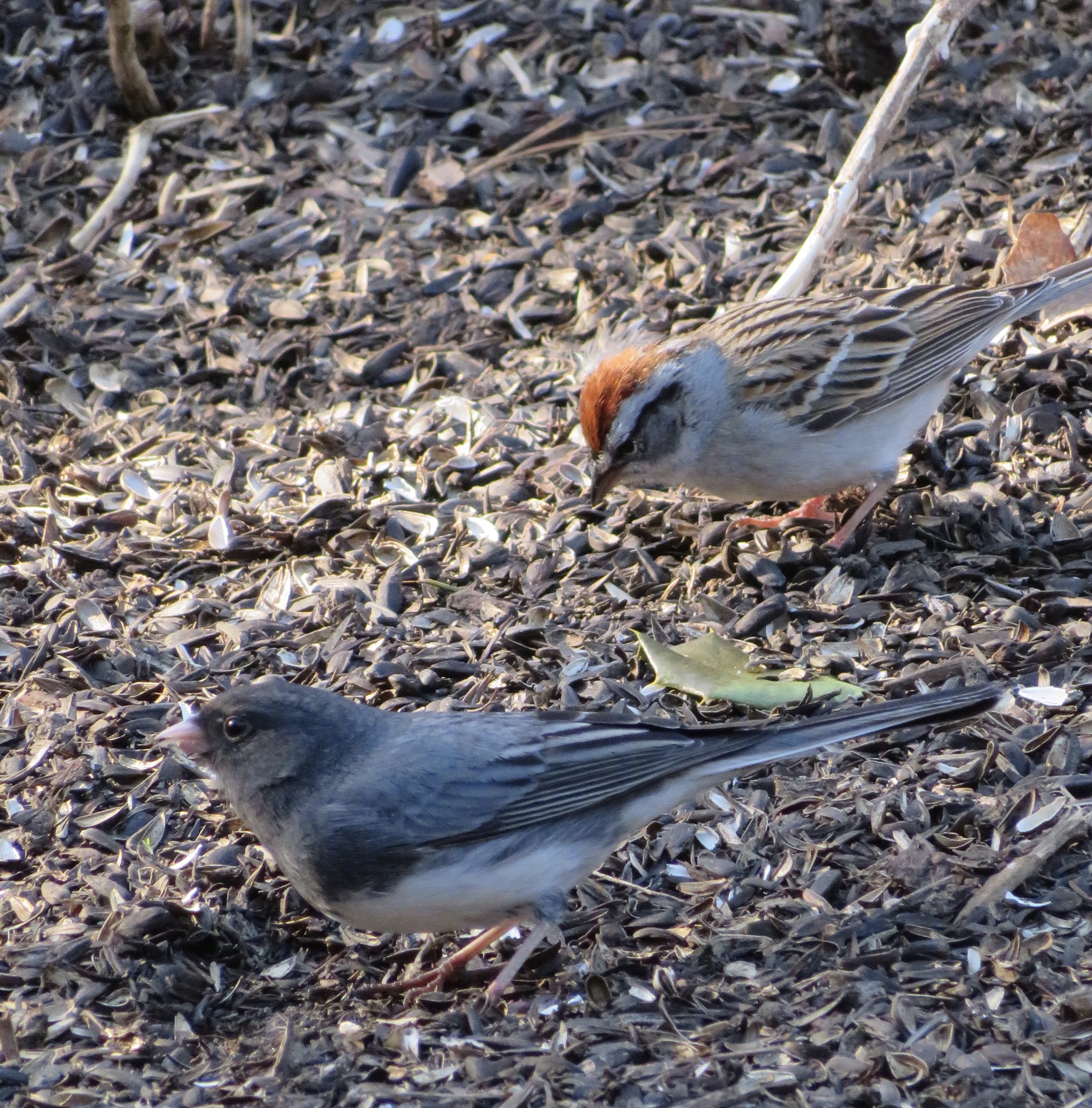
Observer: Wayne Gelfman
Observation Date: 7/24/23
Observation Time: around 6:00 a.m.
Observation Location: near Sharon Community Center
Common Name: Chukar
Scientific Name: Alectoris chukar
Comments: Chukars were introduced to the United States from Pakistan in 1893. Between 1931 and 1970, additional introductions in the western U.S. helped establish wild populations in 10 western states (California, Idaho, Nevada, Washington, Arizona, Colorado, Montana, Oregon, Utah, Wyoming) and in British Columbia, Canada. Now they are common in the western United States and British Columbia.
So what’s this one doing in Sharon? Was it released from captivity?
More Information: All About Birds
Observer: Paul Lauenstein
Observation Date: 4/23/24
Observation Time: 10:00 a.m.
Observation Location: Moose Hill Audubon Wildlife Sanctuary
Common Name: Common Grackle
Scientific Name: Quiscalus quiscula
Comments: Grackles are irridescent in the sunlight.
More Information: All About Birds
Observer: Ilan Fisher
Observation Date: 6/12/2018
Observation Time: N/A
Observation Location: near Lake Massapoag
Common Name: Common Grackle
Scientific Name: Quiscalus quiscula
Comments: I love this guy and he loves this feeder. With his yellow eyes and black cape, I call him “Count Gracula.” He is fun to watch.
More Information: All About Birds
Observer: Paul Lauenstein
Observation Date: 6/30/2014
Observation Time: 3:50 pm
Observation Location: near Gavins Pond
Common Name: Common Grackle
Scientific Name: Quiscalus quiscula
Comments: You might see a Common Grackle hunched over on the ground, wings spread, letting ants crawl over its body and feathers. This is called anting, and grackles are frequent practitioners among the many bird species that do it. The ants secrete formic acid, the chemical in their stings, and this may rid the bird of parasites.
More Information: All About Birds
Observer: Deb Radovsky
Observation Date: 2/26/18
Observation Time: N/A
Observation Location: Lake Massapoag
Common Name: Common Merganser
Scientific Name: Mergus merganser
Comments: Common Mergansers are sometimes called sawbills, fish ducks, or goosanders. The word “merganser” comes from the Latin and roughly translates to “plunging goose”—a good name for this very large and often submerged duck.
Young Common Mergansers leave their nest hole within a day or so of hatching. The flightless chicks leap from the nest entrance and tumble to the forest floor. The mother protects the chicks, but they catch all of their own food. They start by diving for aquatic insects and switch over to fish at about 12 days old.
More Information: All About Birds
Observer: Paul Lauenstein
Observation Date: 5/5/18
Observation Time: 6:00 p.m.
Observation Location: Moose Hill Audubon Wildlife Sanctuary
Common Name: Common Raven
Scientific Name: Corvus corax
Comments: Ravens are considerably larger than crows. Their call is different and they travel in pairs, unlike crows, which travel in larger groups. For more information, see: http://www.audubon.org/field-guide/bird/common-raven. Sharon is at the southern edge of the raven’s range. Be sure to scroll down and check out the map showing how the raven’s range is expected to retreat northward as the climate heats up.
More Information: All About Birds
Observer: Paul Lauenstein
Observation Date: 5/11/18
Observation Time: 8:35 a.m.
Observation Location: Moose Hill Audubon Wildlife Sanctuary
Common Name: Common Yellowthroat
Scientific Name: Geoothlypis trichas
Comments: Common yellowthroats are typically found in or near wetlands. They are a type of warbler, with a distinctive black mask that is reminiscent of a raccoon. Their song sounds like, “witchety, witchety, witchety.”
More Information: All About Birds
Observer: Paul Lauenstein
Observation Date: 5/11/20
Observation Time: 10:00 a.m.
Observation Location: near Billings Brook wetlands under the high tension lines across the street from Gavins Pond soccer fields
Common Name: Common Yellowthroat
Scientific Name: Geoothlypis trichas
Comments: Common yellowthroats are typically found in or near wetlands. They are a type of warbler, with a distinctive black mask that is reminiscent of a raccoon. Their song sounds like, “witchety, witchety, witchety.”
More Information: All About Birds
I took this photo at the same place two days later:
Observer: Paul Lauenstein
Observation Date: 5/11/23
Observation Time: 9:30 a.m.
Observation Location: Moose Hill Audubon Wildlife Sanctuary (boardwalk)
Common Name: Common Yellowthroat
Scientific Name: Geoothlypis trichas
Comments: Common yellowthroats are typically found in or near wetlands. They are a type of warbler, with a distinctive black mask that is reminiscent of a raccoon. Their song sounds like, “witchety, witchety, witchety.”
More Information: All About Birds
Observer: Paul Lauenstein
Observation Date: 5/14/14
Observation Time: 2:35 p.m.
Observation Location: Moose Hill Audubon Wildlife Sanctuary
Common Name: Common yellowthroat
Scientific Name: Geothlypis trichas
Comments: This masked warbler is typically found near wetlands or ponds.
More Information: All About Birds

Observer: Paul Lauenstein
Observation Date: 5/15/15
Observation Time: 10:45 a.m.
Observation Location: Moose Hill Audubon Wildlife Sanctuary
Common Name: Common Yellowthroat
Scientific Name: Geoothlypis trichas
Comments: Common yellowthroats are typically found in or near wetlands. They are a type of warbler, with a distinctive black mask that is reminiscent of a raccoon. Their song sounds like, “witchety, witchety, witchety.”
More Information: All About Birds
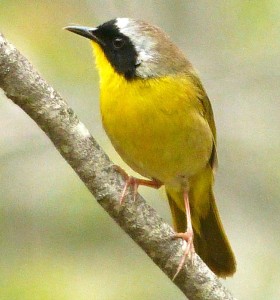
Observer: Paul Lauenstein
Observation Date: 5/26/19
Observation Time: 1:30 p.m.
Observation Location: Moose Hill Farm (formerly the Kendall Estate)
Common Name: Common Yellowthroat
Scientific Name: Geoothlypis trichas
Comments: Common yellowthroats are typically found in or near wetlands. They are a type of warbler, with a distinctive black mask that is reminiscent of a raccoon. Their song sounds like, “witchety, witchety, witchety.”
More Information: All About Birds
Observer: Paul Lauenstein
Observation Date: 5/7/24
Observation Time: 9:00 a.m.
Observation Location: Moose Hill Audubon Wildlife Sanctuary (boardwalk)
Common Name: Common Yellowthroat
Scientific Name: Geoothlypis trichas
Comments: Common yellowthroats are typically found in or near wetlands. They are a type of warbler, with a distinctive black mask that is reminiscent of a raccoon. Their song sounds like, “witchety, witchety, witchety.”
More Information: All About Birds
Observer: Joe Blansfield
Observation Date: 5/9/24
Observation Time: 12:30 p.m.
Observation Location: Bay Road, Sharon (on the deck)
Common Name: Common Yellowthroat
Scientific Name: Geoothlypis trichas
Comments: This guy crashed into my sliding glass door as I was reading the paper. He was temporarily stunned, but he recovered and went on his merry way!
Common yellowthroats are typically found in or near wetlands. They are a type of warbler, with a distinctive black mask that is reminiscent of a raccoon. Their song sounds like, “witchety, witchety, witchety.”
More Information: All About Birds
Observer: Paul Lauenstein
Observation Date: 5/9/25
Observation Time: 8:30 a.m.
Observation Location: Moose Hill Audubon Wildlife Sanctuary (boardwalk)
Common Name: Common Yellowthroat
Scientific Name: Geoothlypis trichas
Comments: Common yellowthroats are typically found in or near wetlands. They are a type of warbler, with a distinctive black mask that is reminiscent of a raccoon. Their song sounds like, “witchety, witchety, witchety.”
More Information: All About Birds
Observer: Paul Lauenstein
Observation Date: 10/1/11
Observation Time: 9:10 a.m.
Observation Location: 4 Gavins Pond Road
Common Name: Cooper’s hawk
Scientific Name: Accipiter cooperii
Comments: This juvenile female Cooper’s hawk alit in the dogwood tree right outside my living room window as I was working at my desk. Without getting up, I reached for my camera and snapped this photo through the window just before it flew away.
Cooper’s hawks look like Sharp-shinned hawks, but Cooper’s hawks have a more rounded tail. Also, the streaks on the breast of a juvenile Cooper’s hawk are narrower than those on the breast of a sharp-shinned hawk.
More Information: All About Birds
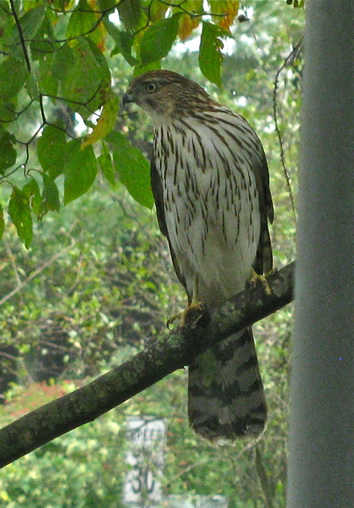
Observer: Jean Zaniewski
Observation Date: 12/28/24
Observation Time: N/A
Observation Location: Old Post Rd
Common Name: Cooper’s hawk
Scientific Name: Accipiter cooperii
Comments: We interrupted this Cooper’s hawk as it was tearing apart a rodent under a bush beside our house.
More Information: All About Birds
Observer: Paul Lauenstein
Observation Date: 8/18/12
Observation Time: 5:20 p.m.
Observation Location: 4 Gavins Pond Road (back yard)
Common Name: Cooper’s hawk
Scientific Name: Accipiter cooperii
Comments: This Cooper’s hawk perched on a branch in my back yard, and I photographed it through the window. Note the rounded tail, which differentiates it from a sharp-shinned hawk.
More Information: All About Birds
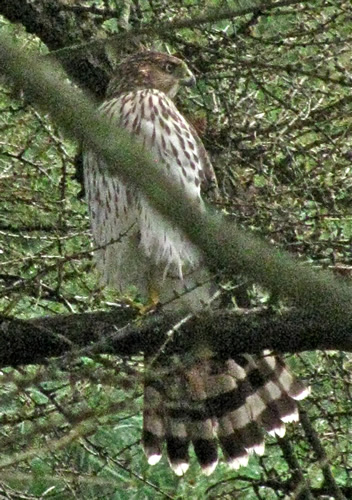
Observer: Josh Simons
Observation Date: 1/1/09
Observation Time: 2:00 p.m.
Observation Location: Moose Hill Parkway
Common Name: Dark-eyed Junco
Scientific Name: Junco hyemalis
Comments: This and the titmouse and wren photos were all taken with a Canon 50D and a Canon 500mm f4 lens from the comfort of my kitchen on Moose Hill Parkway. We have feeders that attract lots of birds who land on a nearby lilac bush while waiting for their turn at the feeders.
In terms of processing, I use very little. The images are cropped and very small
adjustments are made to exposure and contrast with sometimes a little extra
sharpening applied.
That and the nice, slanting winter sunlight are all there is to it.
More Information: Cornell Lab of Ornithology “All About Birds”
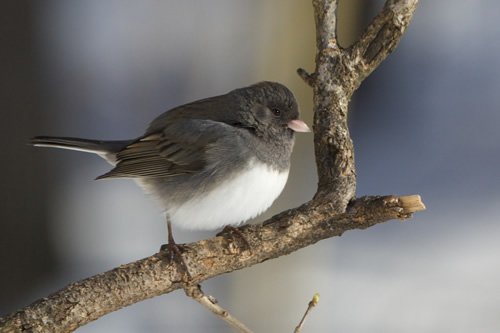
Observer: Paul Lauenstein
Observation Date: 12/18/20
Observation Time: 8:35 a.m.
Observation Location: Gavins Pond Rd. (our back yard)
Common Name: Dark-eyed Junco
Scientific Name: Junco hyemalis
Comments: Juncos are a type of sparrow commonly seen around Sharon in winter. They head north in spring and don’t return until fall.
More Information: Cornell Lab of Ornithology “All About Birds”
Observer: Paul Lauenstein
Observation Date: 3/8/14
Observation Time: 10:55 a.m.
Observation Location: Moose Hill Audubon Wildlife Sanctuary
Common Name: Dark-eyed Junco
Scientific Name: Junco hyemalis
Comments: Juncos are winter birds in Sharon.
More Information: Cornell Lab of Ornithology “All About Birds”
Previous, Subsequent, or Similar Sightings:

Observer: Paul Lauenstein
Observation Date: 4/18/11
Observation Time: 11:25 a.m.
Observation Location: Gavins Pond
Common Name: Dark-eyed Junco
Scientific Name: Junco hyemalis
Comments: Juncos are a type of sparrow commonly seen around Sharon in winter. This individual will soon be heading north for summer.
More Information: Cornell Lab of Ornithology “All About Birds”
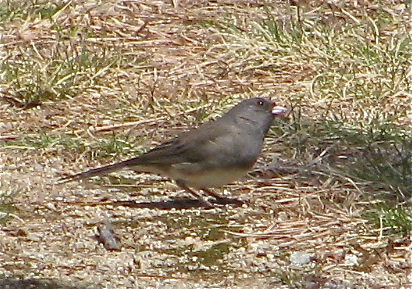
Observer: Paul Lauenstein
Observation Date: 4/25/24
Observation Time: 7:00 a.m.
Observation Location: Moose Hill Audubon Wildlife Sanctuary
Common Name: Double-crested Cormorant
Scientific Name: Phalacrocorax auritus
Comments: The oldest known Double-crested Cormorant was at least 23 years, 8 months old. It was banded in Oregon in 1997 and spotted by a bird watcher in Washington in 2021.
More Information: All About Birds
Observer: Paul Lauenstein
Observation Date: 5/7/19
Observation Time: 7:42 a.m.
Observation Location: Moose Hill Audubon Wildlife Sanctuary
Common Name: Double-crested Cormorant
Scientific Name: Phalacrocorax auritus
Comments: When migrating, cormorants fly loosely in lines, as opposed to the familiar “vees” that geese use.
More Information: All About Birds
Observer: Paul Lauenstein
Observation Date: 9/1/12
Observation Time: 4:40 p.m.
Observation Location: Gavins Pond outflow pool
Common Name: Double-crested Cormorant
Scientific Name: Phalacrocorax auritus
Comments: Most commonly seen cormorant in the East and usually the only one seen inland. Feeds by diving and swimming underwater, eating mostly fish. After feeding, often stands with wings outstretched to dry.
More Information: All About Birds
Observer: Deb Radovsky
Observation Date: 10/27/17
Observation Time: early morning
Observation Location: Lake Massapoag
Common Name: Double-crested Cormorants
Scientific Name: Phalacrocorax auritus
Comments: The double-crest of the Double-crested Cormorant is only visible on adults during breeding season. The crests are white in cormorants from Alaska, and black in other regions.
More Information: All About Birds
Observer: Rick Dumont
Observation Date: 1/26/08
Observation Time: 4:15 p.m.
Observation Location: Front yard
Common Name: Downy Woodpecker
Scientific Name: Picoides pubescens
Comments: First the male showed up, then along came the female. The male has a moustache and red stripe while the female is clean-shaven and stripeless.
More Information: All-Birds.com
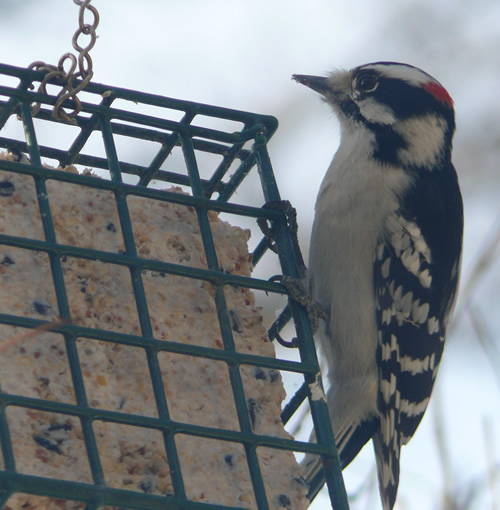
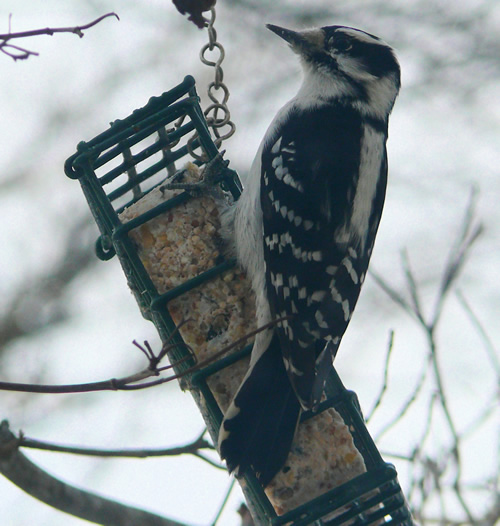
Observer: Josh Simons
Observation Date: 2/16/14
Observation Time: 9:00 a.m.
Observation Location: Moose Hill area
Common Name: Downy Woodpecker
Scientific Name: Dendrocopos pubescens
Comments: Dendrocopos means “tree dagger” and “pubescens” refers to its downy hairs of puberty compared to those of the Hairy woodpecker, D. villosus.[The Dictionary of American Bird Names by Ernest A. Choate]
More Information: All About Birds

Observer: Paul Lauenstein
Observation Date: 4/15/20
Observation Time: 2:00 p.m.
Observation Location: Conservation land near Sandy Ridge Circle
Common Name: Downy Woodpecker
Scientific Name: Dendrocopos pubescens
Comments: Dendrocopos means “tree dagger” and “pubescens” refers to its downy hairs of puberty compared to those of the Hairy woodpecker, D. villosus. [The Dictionary of American Bird Names by Ernest A. Choate]
More Information: All About Birds
Observer: Josh Simons
Observation Date: 5/10/20
Observation Time: 1:00 p.m.
Observation Location: Moose Hill area
Common Name: Downy Woodpecker
Scientific Name: Dryobates pubescens
Comments: “Pubescens” refers to its downy hairs of puberty compared to those of the Hairy woodpecker, D. villosus. [The Dictionary of American Bird Names by Ernest A. Choate]
More Information: All About Birds
Observer: Paul Lauenstein
Observation Date: 5/16/13
Observation Time: 6:30 a.m.
Observation Location: Moose Hill Audubon Wildlife Sanctuary
Common Name: Downy Woodpecker
Scientific Name: Picoides pubescens
Comments: This pair of small, common woodpeckers was hollowing out a nesting cavity in a dead tree.
More Information: All About Birds
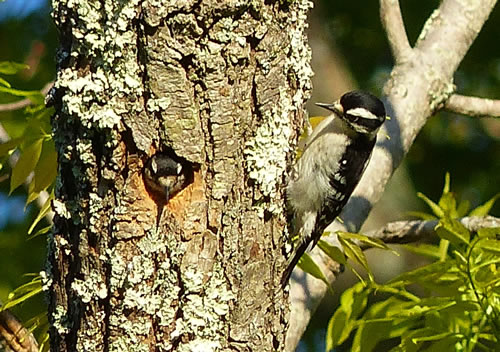
Observer: Paul Lauenstein
Observation Date: 5/5/18
Observation Time: 7:20 a.m.
Observation Location: Moose Hill Audubon Wildlife Sanctuary
Common Name: Downy Woodpecker
Scientific Name: Dendrocopos pubescens
Comments: Dendrocopos means “tree dagger” and “pubescens” refers to its downy hairs of puberty compared to those of the Hairy woodpecker, D. villosus.[The Dictionary of American Bird Names by Ernest A. Choate]
More Information: All About Birds
Observer: Ilan Fisher
Observation Date: 8/22/20
Observation Time: 2:00 p.m.
Observation Location: near intersection of Beach & Harding Streets
Common Name: Downy Woodpecker
Scientific Name: Dryobates pubescens
Comments: “Pubescens” refers to its downy hairs of puberty compared to those of the Hairy woodpecker, D. villosus. [The Dictionary of American Bird Names by Ernest A. Choate]
Downy woodpeckers look very much like hairy woopeckers, but downy woodpeckers are much smaller than hairy woodpeckers. To learn more about how to tell them apart, see: Project Feederwatch.
More Information: All About Birds
Observer: Ilan Fisher
Observation Date: 8/6/08
Observation Time: 2:00 p.m.
Observation Location: 66 N. Main Street
Common Name: Downy Woodpecker
Scientific Name: Picoides pubescens
Comments: Just visiting in a tree in front of the house.
More Information: All-Birds.com
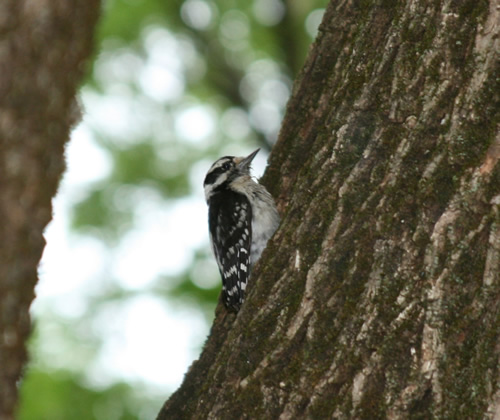
Observer: Faith Berkland
Observation Date: 10/8/17
Observation Time: 5:15 p.m.
Observation Location: Fence of horse corral, Willow St, Foxboro
Common Name: Eastern Bluebird
Scientific Name: Sialia sialis
Comments: 3 bluebirds were spotted here, 1 bright blue, one maybe an immature male because less bright, and one female.
More Information: All About Birds
Observer: Barry Dulong
Observation Date: 11/1/24
Observation Time: 3:30 p.m.
Observation Location: Moose Hill Audubon Wildlife Sanctuary – large field near barn
Common Name: Eastern Bluebird
Scientific Name: Sialia sialis
Comments: I am only reporting the sighting because it is November 1st and thought it was very late in the season to see Bluebirds. I had not seen them since mid August…..but yesterday I saw 3 or 4.
More Information: All About Birds
Observer: Steven Woolner
Observation Date: 2/14/22
Observation Time: 2:00 p.m.
Observation Location: Osprey Road
Common Name: Eastern Bluebird
Scientific Name: Sialia sialis
Comments: Delighted to see Bluebirds at my feeder for the first time in 25+ years! I use Lyric Waste Free feed. They have also been visiting my birdbath 20 feet away, which luckily had water instead of ice, due to the recent warm spell.
On cold nights in winter, bluebirds huddle together to use their body heat to survive cold weather. See: https://www.pinterest.com/pin/319263061075187526/
More Information: All About Birds
Observer: Marshall Katler
Observation Date: 3/21/25
Observation Time: 1:30 p.m.
Observation Location: Mansfield Street
Common Name: Eastern Bluebird
Scientific Name: Sialia sialis
Comments: At least one male and 2 females have been at our suet feeder since March 4, 2025. Bluebirds are looking for good nesting places at this time of year (early spring).
More Information: All About Birds
Observer: Paul Lauenstein
Observation Date: 4/17/20
Observation Time: 2:00 p.m.
Observation Location: conservation land near Morse & Lakeview
Common Name: Eastern Bluebird
Scientific Name: Sialia sialis
Comments: The Sharon Friends of Conservation maintains six bluebird nesting boxes at this site. Most of them are occupied by tree swallows.
More Information: All About Birds
Observer: Paul Lauenstein
Observation Date: 4/23/24
Observation Time: 11:00 a.m.
Observation Location: Moose Hill Audubon Wildlife Sanctuary
Common Name: Eastern Bluebird
Scientific Name: Sialia sialis
Comments: In 1972, DDT was banned (note that bluebirds eat insects), and in 1973, Congress passed the Endangered Species Act. Bluebirds were listed as a Species of Special Concern in several states.
In 1973, the Camp Fire Girls began Project Save the Bluebirds. Projects like this instilled a greater love and respect for living things and an understanding of the serious problems faced by wildlife. Since then, various Boy Scout, Girl Scout, and 4-H Clubs have also organized bluebird projects.
For more on the history of bluebirds, see: https://www.sialis.org/history.htm
The Sharon Friends of Conservation maintains about 30 bluebird nesting boxes aound town. Volunteers monitor the nesting activity of the bluebirds, tree swallows, chickadees, and other birds that nest in them. Moose Hill Audubon Wildlife Sanctuary also maintains numerous bluebird nesting boxes. Thanks to efforts like these, bluebirds are once again easy to find in Sharon, if you know when and where to look.
More Information: All About Birds
Observer: Paul Lauenstein
Observation Date: 4/23/25
Observation Time: 8:35 a.m.
Observation Location: Moose Hill Audubon Wildlife Sanctuary
Common Name: Eastern Bluebird
Scientific Name: Sialia sialis
Comments: In 1972, DDT was banned (note that bluebirds eat insects), and in 1973, Congress passed the Endangered Species Act. Bluebirds were listed as a Species of Special Concern in several states.
In 1973, the Camp Fire Girls began Project Save the Bluebirds. Projects like this instilled a greater love and respect for living things and an understanding of the serious problems faced by wildlife. Since then, various Boy Scout, Girl Scout, and 4-H Clubs have also organized bluebird projects.
For more on the history of bluebirds, see: https://www.sialis.org/history.htm
The Sharon Friends of Conservation maintains about 30 bluebird nesting boxes aound town. Volunteers monitor the nesting activity of the bluebirds, tree swallows, chickadees, and other birds that nest in them. Moose Hill Audubon Wildlife Sanctuary also maintains numerous bluebird nesting boxes. Thanks to efforts like these, bluebirds are once again easy to find in Sharon, if you know when and where to look.
More Information: All About Birds
Observer: Paul Lauenstein
Observation Date: 4/25/09
Observation Time: 11:05 a.m.
Observation Location: Moose Hill Audubon Wildlife Sanctuary
Common Name: Eastern Bluebird
Scientific Name: Sialia sialis
Comments: Female (above) and male (below)
More Information: Cornell Lab of Ornithology “All About Birds”
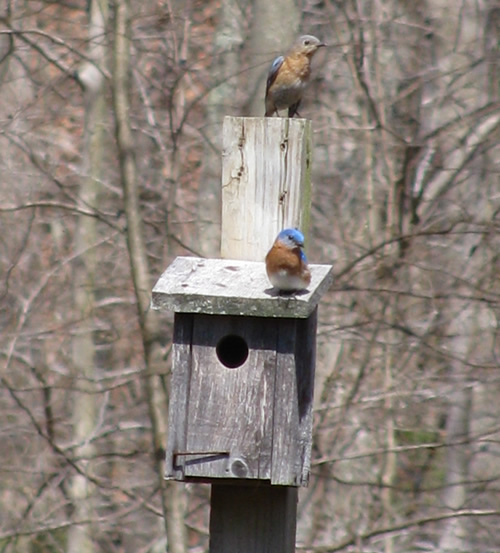
Observer: Paul Lauenstein
Observation Date: 4/25/20
Observation Time: 9:00 a.m.
Observation Location: Moose Hill Farm (TTOR)
Common Name: Eastern Bluebird
Scientific Name: Sialia sialis
Comments: The Sharon Friends of Conservation maintains some bluebird nesting boxes at this site. Volunteers monitor these nesting boxes and keep track of the bluebirds’ nesting activities.
More Information: All About Birds
Observer: Faith Berkland
Observation Date: 4/14/18
Observation Time: 3:30 p.m.
Observation Location: 302 Mansfield Street
Common Name: Eastern Bluebird
Scientific Name: Sialia sialis
More Information: All About Birds or Animalia
Observer: Paul Lauenstein
Contact Information: lauenstein@comcast.net (781) 784-2986
Observation Date: 5/1/18
Observation Time: 8:45 a.m.
Observation Location: Moose Hill Wildlife Sanctuary
Common Name: Eastern Bluebird
Scientific Name: Sialia sialis
Comments: This male bluebird caught a spider and brought it back to the nest to feed its young.
More Information: All About Birds
Observer: Paul Lauenstein
Observation Date: 5/11/20
Observation Time: 8:10 a.m.
Observation Location: field near Gavins Pond dam
Common Name: Eastern Bluebird
Scientific Name: Sialia sialis
Comments: The male bluebird caught an insect and gave it to its mate. The Sharon Friends of Conservation maintains six bluebird nesting boxes near Gavins Pond. Most of them are occupied by tree swallows.
More Information: All About Birds
Observer: Paul Lauenstein
Observation Date: 5/13/19
Observation Time: 11:00 a.m.
Observation Location: Moose Hill Audubon Wildlife Sanctuary
Common Name: Eastern Bluebird
Scientific Name: Sialia sialis
Comments: This male was guarding the territory near a nesting box where his mate had laid her blue eggs.
More Information: All About Birds
Observer: Paul Lauenstein
Observation Date: 5/14/14
Observation Time: 2:25 p.m.
Observation Location: Moose Hill Audubon Wildlife Sanctuary
Common Name: Eastern Bluebird
Scientific Name: Sialia sialis
Comments: Sharon Fiends of Conservation maintain about 30 bluebird houses in town. Volunteers check the bluebird houses weekly, and the data is used to help determine the optimum locations for bluebird houses.
More Information: All About Birds
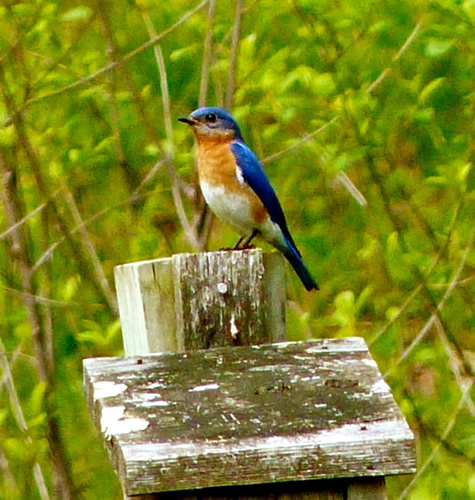
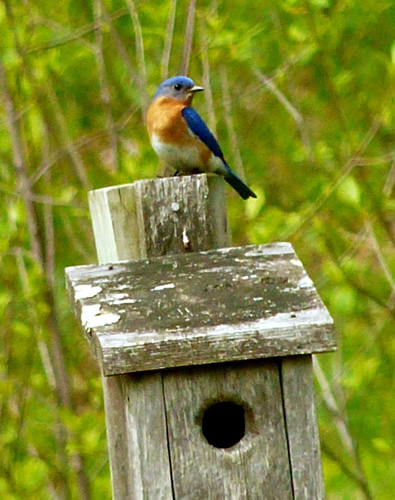
Observer: Paul Lauenstein
Observation Date: 5/18/23
Observation Time: 6:15 p.m.
Observation Location: Moose Hill Audubon Wildlife Sanctuary
Common Name: Eastern Bluebird
Scientific Name: Sialia sialis
Comments: In 1972, DDT was banned (note that bluebirds eat insects), and in 1973, Congress passed the Endangered Species Act. Bluebirds were listed as a Species of Special Concern in several states.
In 1973, the Camp Fire Girls began Project Save the Bluebirds. Projects like this instilled a greater love and respect for living things and an understanding of the serious problems faced by wildlife. Since then, various Boy Scout, Girl Scout, and 4-H Clubs have also organized bluebird projects.
For more on the history of bluebirds, see: https://www.sialis.org/history.htm
The Sharon Friends of Conservation maintains about 30 bluebird nesting boxes aound town. Volunteers monitor the nesting activity of the bluebirds, tree swallows, chickadees, and other birds that nest in them. Moose Hill Audubon Wildlife Sanctuary also maintains numerous bluebird nesting boxes. Thanks to efforts like these, bluebirds are once again easy to find in Sharon, if you know when and where to look.
More Information: All About Birds
Observer: Deb Radovsky
Observation Date: 5/2/18
Observation Time: 6:30 a.m.
Observation Location: Moose Hill Audubon Wildlife Sanctuary (Wood Thrush Trail)
Common Name: Eastern Bluebird
Scientific Name: Sialia sialis
Comments: You can find Eastern Bluebirds in open country with patchy vegetation and large trees or nest boxes. Meadows, old fields, and golf courses are good places. Bluebirds typically sit in the open on power lines or along fences, with an alert, vertical posture. When they drop to the ground after an insect, they make a show of it, with fluttering wings and a fairly slow approach, followed by a quick return to the perch.
More Information: All About Birds
Observer: Paul Lauenstein
Observation Date: 5/3/15
Observation Time: 1:55 p.m.
Observation Location: field near Gavins Pond
Common Name: Eastern Bluebird
Scientific Name: Sialia sialis
Comments: I found a couple of sky-blue eggs in one of the nesting boxes near Gavins Pond. Then I saw the parents. As I was snapping photos of the male bluebird, it suddenly stretched out its wing. A moment later it was gone.
More Information: National Audubon Society
Observer: Paul Lauenstein
Observation Date: 5/4/25
Observation Time: 8:20 a.m.
Observation Location: Moose Hill Audubon Wildlife Sanctuary
Common Name: Eastern Bluebird
Scientific Name: Sialia sialis
Comments: Most of the nesting boxes near the barn on the Billings Loop are occupied by tree swallows, which tend to be more aggressive than bluebirds, but at least one pair of bluebirds has managed to occupy a nesting box.
More Information: All About Birds
Observer: Jean Zaniewski
Observation Date: 5/5/24
Observation Time: 3:15 p.m.
Observation Location: Moose Hill Audubon Wildlife Sanctuary near the barn on the Billings loop
Common Name: Eastern Bluebird
Scientific Name: Sialia sialis
Comments: I am a new bluebird monitor this year (through Friends Of Conservation). After stealthily checking a dozen boxes once a week since March, I was really thrilled on May 5 to finally see bluebirds nesting in two of the boxes, and that they tolerated a brief phone camera documentation.
In 1972, DDT was banned (note that bluebirds eat insects), and in 1973, Congress passed the Endangered Species Act. Bluebirds were listed as a Species of Special Concern in several states.
In 1973, the Camp Fire Girls began Project Save the Bluebirds. Projects like this instilled a greater love and respect for living things and an understanding of the serious problems faced by wildlife. Since then, various Boy Scout, Girl Scout, and 4-H Clubs have also organized bluebird projects.
For more on the history of bluebirds, see: https://www.sialis.org/history.htm
The Sharon Friends of Conservation maintains about 30 bluebird nesting boxes aound town. Volunteers monitor the nesting activity of the bluebirds, tree swallows, chickadees, and other birds that nest in them. Moose Hill Audubon Wildlife Sanctuary also maintains numerous bluebird nesting boxes. Thanks to efforts like these, bluebirds are once again easy to find in Sharon, if you know when and where to look.
More Information: All About Birds
Observer: Paul Lauenstein
Observation Date: 5/8/19
Observation Time: 9:40 a.m.
Observation Location: Moose Hill Audubon Wildlife Sanctuary
Common Name: Eastern Bluebird
Scientific Name: Sialia sialis
Comments: This male was guarding the territory surrounding a nesting box where his mate had laid her blue eggs.
More Information: All About Birds
Observer: Paul Lauenstein
Observation Date: 6/21/25
Observation Time: 5:00 p.m.
Observation Location: Moose Hill Farm (TTOR)
Common Name: Eastern Bluebird
Scientific Name: Sialia sialis
Comments: This male bluebird perched on a fence post by the road through the big pastures.
More Information: All About Birds
Observer: Rita Corey
Observation Date: 6/23/19
Observation Time: 3:30 p.m.
Observation Location: 282 Mountain Street (back yard)
Common Name: Eastern Bluebird
Scientific Name: Sialia sialis
Comments: This bluebird was checking out the bluebird house. Note that the entrance hole has been gnawed by a squirrel. The extra piece of wood that’s attached around the hole makes it harder for squirrels to enlarge the hole enough to get inside.
More Information: All About Birds
Observer: Paul Lauenstein
Observation Date: 9/30/10
Observation Time: 9:25 a.m.
Observation Location: Gavins Pond Road near soccer fields
Common Name: Eastern Bluebird
Scientific Name: Sialia sialis
Comments: Bluebirds are becoming an increasingly common sight in the open fields bordered by woods in the vicinity of the soccer fields on Gavins Pond Road, thanks to the nesting boxes provided by SFOC.
More Information: Cornell Lab of Ornithology “All About Birds”
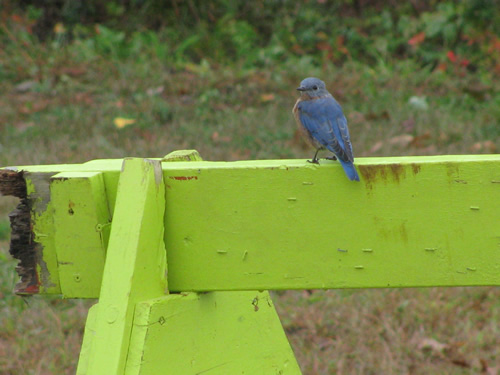
Observer: Paul Lauenstein
Observation Date: 6/27/11
Observation Time: 6:10 p.m.
Observation Location: near Gavins Pond
Common Name: Bluebird (Immature)
Scientific Name: Sialia sialis
Comments: SFOC has installed 38 bluebird nesting boxes around Sharon. This young bluebird is among the first this year to roll off SFOC’s “bluebird factory” assembly line. The speckles on its breast and noticeable white eye-ring indicate that it is a juvenile. Other broods have not yet fledged.
More Information: Cornell Lab of Ornithology “All About Birds”
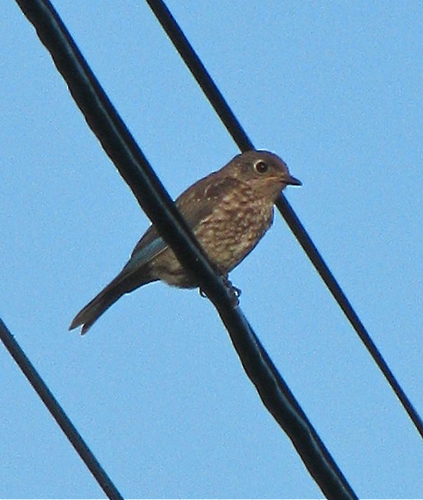
Observer: Paul Lauenstein
Observation Date: 7/15/10
Observation Time: 10:50 a.m.
Observation Location: Gavins Pond Road soccer field parking lot
Common Name: Bluebird (juvenile)
Scientific Name: Sialia sialis
Comments: Young bluebirds that recently left the nest have distinctive white spots on their wings. The presence of this juvenile at the Gavins Pond Road soccer field parking lot indicates the success of SFOC efforts to provide nesting boxes in the vicinity.
More Information: Cornell Lab of Ornithology “All About Birds”
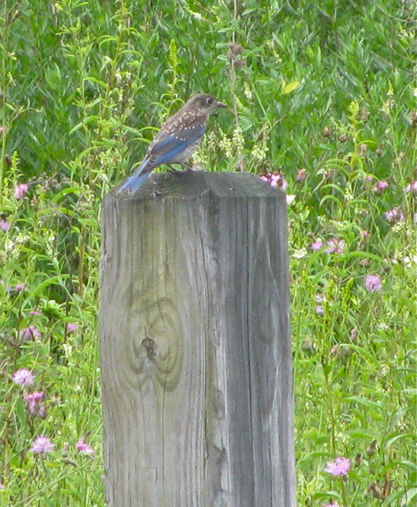
Observer: Paul Lauenstein
Observation Date: 10/9/14
Observation Time: 4:00 p.m.
Observation Location: Gavins Pond soccer field
Common Name: Eastern Bluebird
Scientific Name: Sialia Sialis
Comments: This bluebird was still hanging around Sharon in October. Bluebirds actually overwinter in Sharon, feeding on seeds. On cold nights they huddle in groups inside nesting boxes to keep warm.
More Information: All About Birds
Observer: Paul Lauenstein
Observation Date: 4/25/13
Observation Time: 2:30 p.m.
Observation Location: near Gavins Pond Dam
Common Name: Eastern Bluebird (male)
Scientific Name: Sialia sialis
Comments: This male bluebird was guarding a nest with five sky-blue eggs in a nesting box provided by Kurt Buermann, President of the Sharon Friends of Conservation. The blue color is more or less vivid depending on the brightness and angle of the ambient light.
More Information: All About Birds
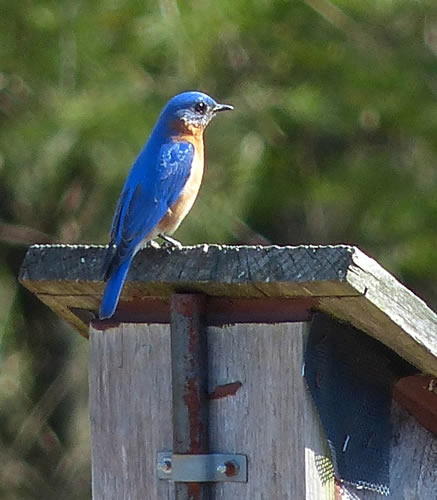
Observer: Paul Lauenstein
Observation Date: 5/19/20
Observation Time: 9:50 a.m.
Observation Location: field near Gavins Pond dam
Common Name: Eastern kingbird
Scientific Name: Tyrannus tyrannus
Comments: Kingbirds are members of the flycatcher family. The tip of the tail looks like it was dipped in white paint. Their call has been likened to the sound of arcing electricity.
In summer kingbirds eat mostly flying insects. Pairs maintain a breeding territory and defend it vigorously against all other kingbirds. In winter along the Amazon, however, they have a very different lifestyle: they travel in flocks and eat fruit.
More Information: All About Birds
Observer: Paul Lauenstein
Observation Date: 6/14/20
Observation Time: 4:40 p.m.
Observation Location: Moose Hill Farm (TTOR)
Common Name: Eastern Kingbird
Scientific Name: Tyrannus tyrannus
Comments: Kingbirds are members of the flycatcher family. The tip of the tail looks like it was dipped in white paint. Their call has been likened to the sound of arcing electricity.
In summer kingbirds eat mostly flying insects. Pairs maintain a breeding territory and defend it vigorously against all other kingbirds. In winter along the Amazon, however, they have a very different lifestyle: they travel in flocks and eat fruit.
More Information: All About Birds

